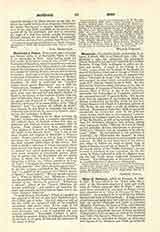

Menestrier, CLAUDE-FRANCOIS, antiquarian, b. at Lyons, March 9, 1631; d. at Paris, January 21, 1705. He inherited a taste for antiquities, his great-uncle Claude Menestrier having been employed by Cardinal Barberini (Urban VIII) as librarian to collect art objects and medals. A pupil of the College of the Trinity, Lyons, which was in charge of the Jesuits, he entered the Society there, and at the age of fifteen was professor of rhetoric; in this capacity he composed the ballets “Destinees de Lyon” and “L’autel de Lyon” and arranged the plays which were performed before Louis XIV when he visited Lyons in 1658. He also directed the festivities which took place at the time of the marriage of Francoise d’Orleans and Charles Emmanuel, Duke of Savoy, as also of the solemnities wherewith the Visitandines of Chambery celebrated the canonization of St. Francis de Sales. But he was more than an organizer of spectacles; he issued important publications on heraldry which led him into violent disputes with Claude le Laboreur, provost of L’lle Barbe; he also made a study of emblems and mottoes. Stationed at Paris from 1670, he preached successfully for twenty-five years in the principal towns, during which time he also composed Latin inscriptions for LeBrun’s prints, for the battle pictures of Van der Meulen, as well as supervising the decorations for Turenne’s obsequies and writing, among other important books, “Histoire de Louis le Grand par les medailles, devises, inscriptions et armoiries” (1689) and “Histoire civile on consulaire de la ville de Lyon” (1696). He had planned a vast synthesis of knowledge, the “Philosophie des images”, in which were to be included his numerous and strangely varied volumes. In 1682 he had discovered in the Cistercian abbey at Villiers the tomb of Queen Anne or Agnes of Russia, second wife of Henry I. In 1770, in the second edition of the “Gallia christiana”, he was accused of falsehood in this connection, but the discovery by Prince Labanoff in 1825 of a diploma bearing the seal of this queen vindicated Menestrier’s memory. The bibliography of Menestrier’s works is so considerable that it disconcerts bibliophiles.
GEORGES GOYAU

